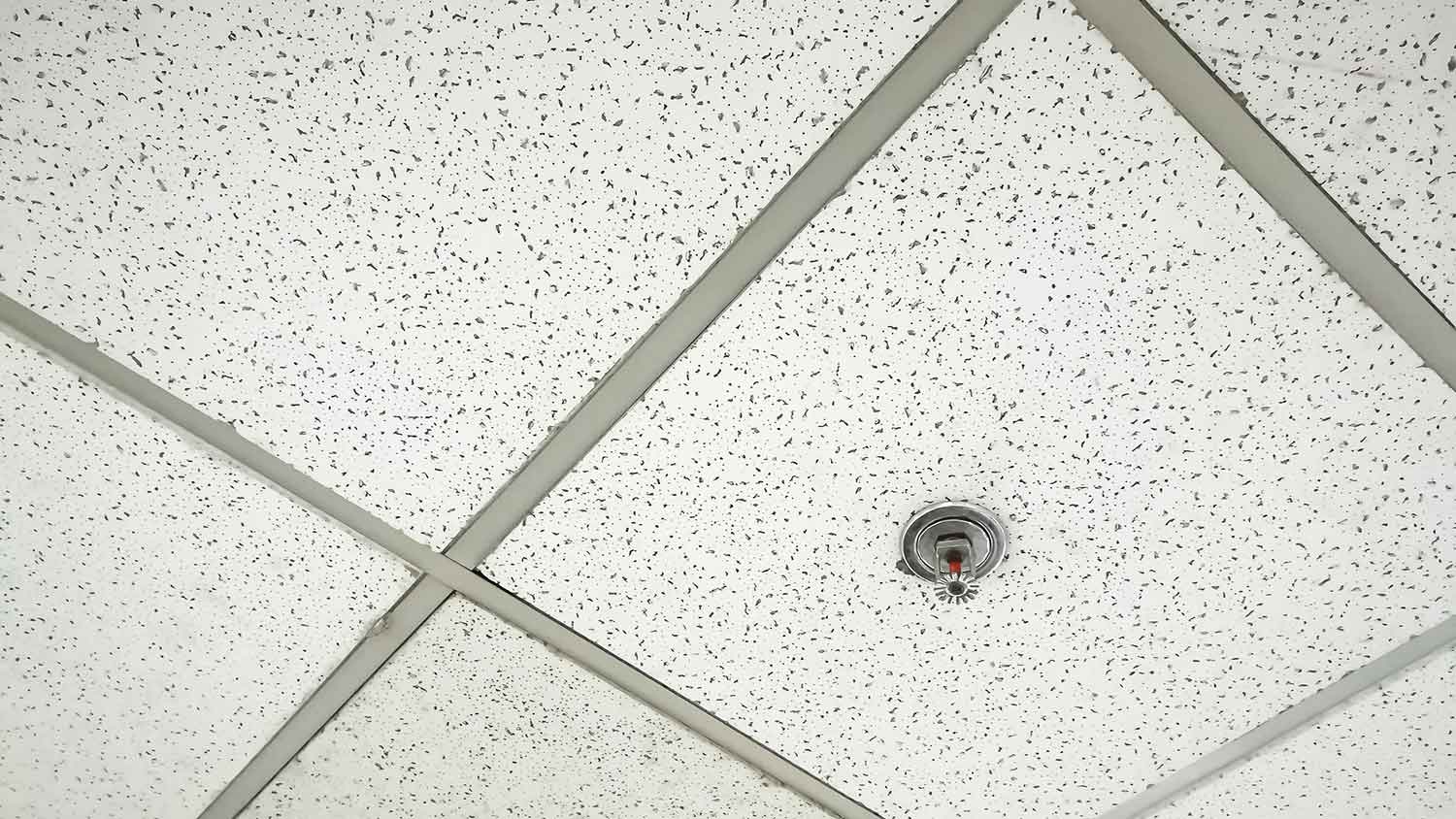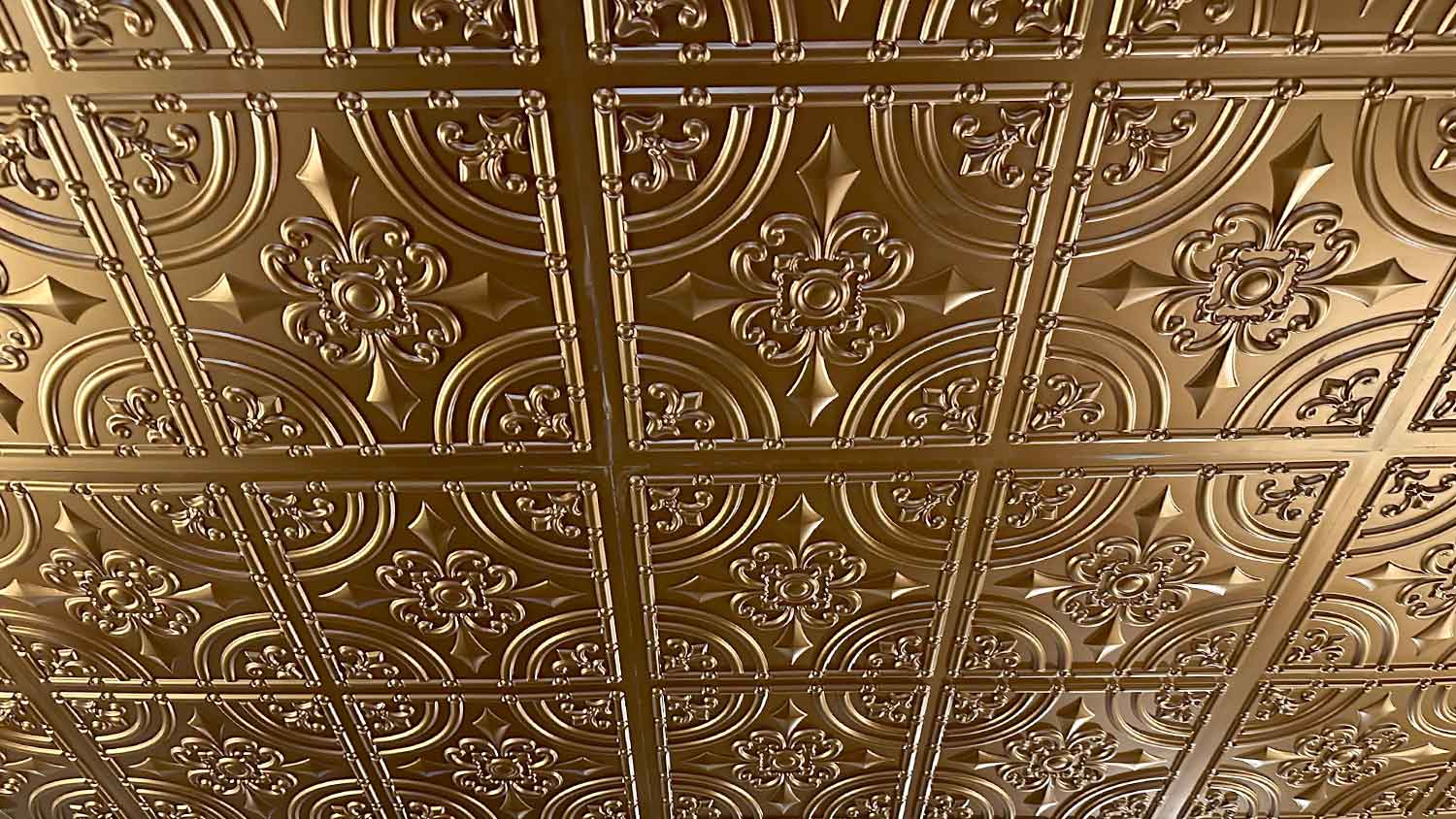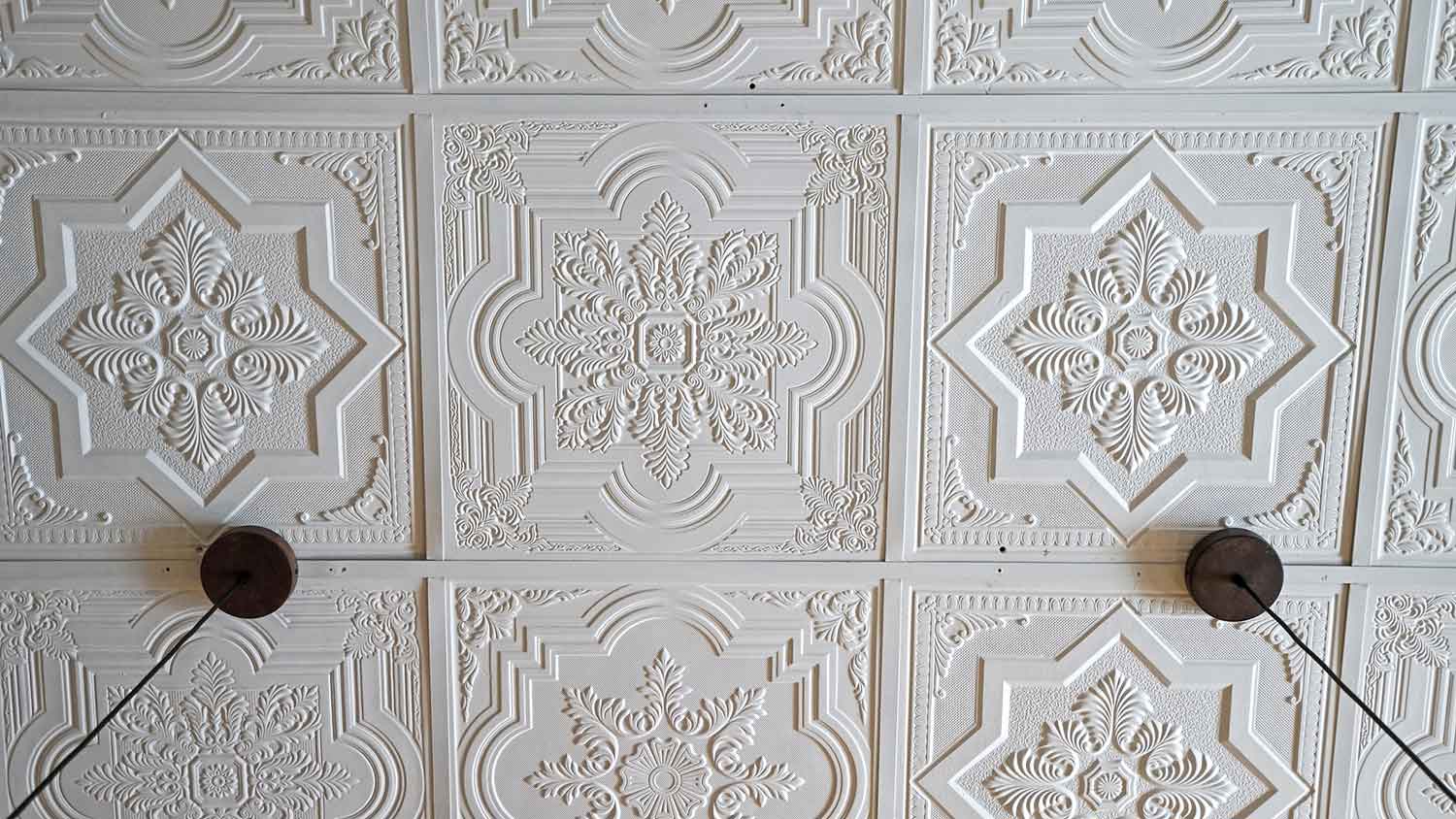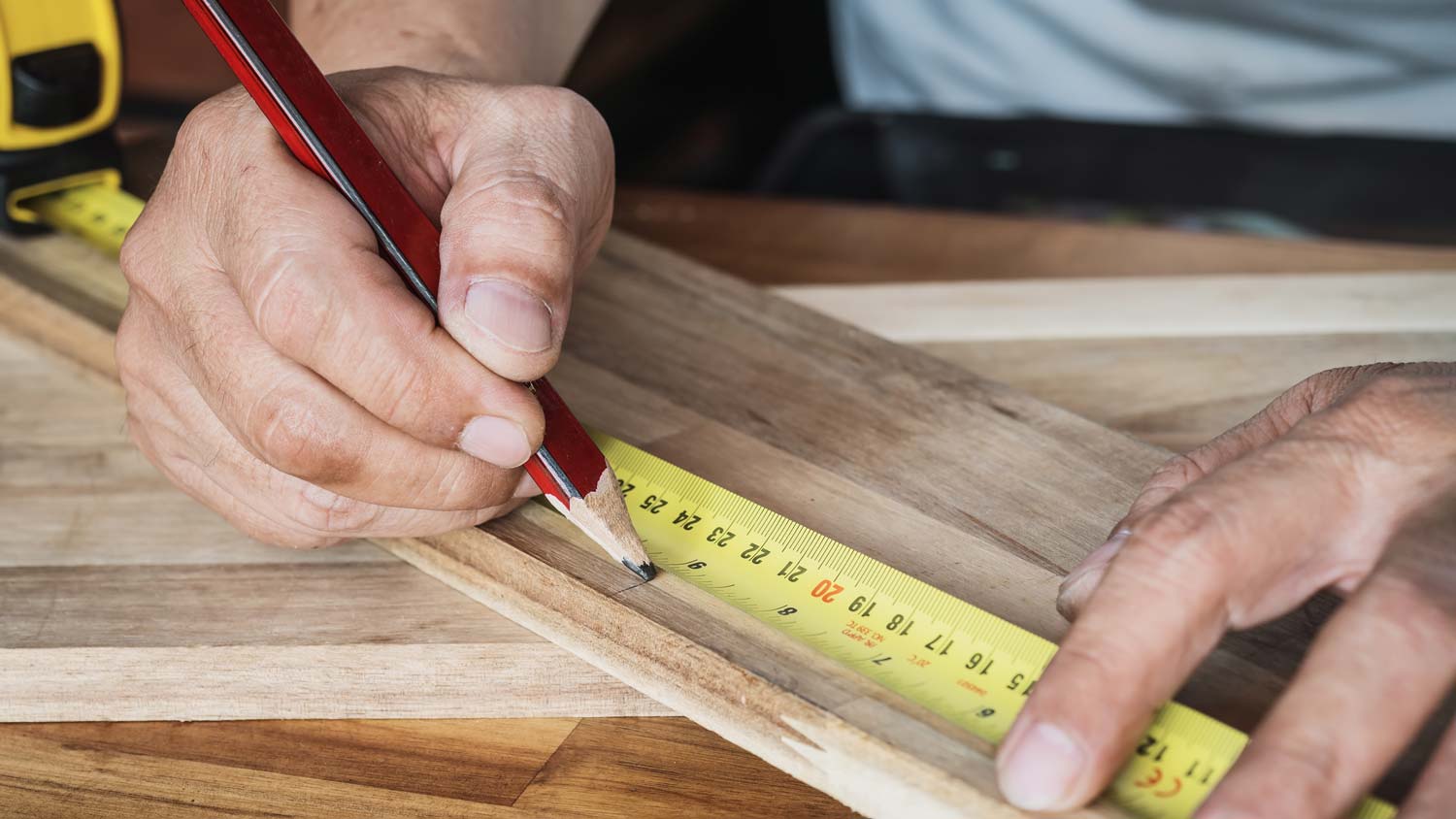
Discover stair repair cost estimates, including average prices, key cost factors, and tips to help you budget for your stair repair project.
Plain or showstopper, it’s your choice


The most traditional ceiling tile material is mineral fiber.
Budget-friendly options like tin and PVC come in faux wood and metal finishes.
A wide range of materials and designs means you'll be able to find the perfect fit.
Ceiling tiles are often associated with offices and classrooms, but they’re also a solid choice for homeowners. Ceiling tiles are commonly made of mineral fiber, metal, or PVC, although the list doesn’t end there. Use plain tiles to keep things simple or make a statement with colorful and decorative designs. We break down ceiling tile materials and how to choose one for your home.
When choosing a ceiling tile material, consider not only the appearance but also the functionality, installation methods, and maintenance needs.

When you imagine ceiling tiles in an office or classroom, you’re most likely thinking of mineral fiber. Manufacturers use a combination of materials to produce these tiles, ranging from recycled newspaper, perlite (expanded volcanic glass), fiberglass, mineral wool, clay, starch, and binders.
These are sometimes called acoustic tiles since they help soundproof ceilings. They’re a good option for stretching your dollar, although some homeowners don’t find them aesthetically pleasing.
Mineral fiber ceiling tiles are white and have a smooth or textured surface. They can be found with moisture- and humidity-resistant additives, though they’re best for rooms with low moisture levels.
Fiber tiles are often used for drop or suspended ceilings, using a metal beam system installed beneath the main ceiling. The tiles fit snugly in the open spaces, making future replacements a breeze.
| Pros | Cons |
|---|---|
| Wallet-friendly | Less aesthetically pleasing than other options |
| Brightens up rooms (white tiles reflect light) | Doesn’t do well in high-moisture spaces |
| Adds sound insulation | No color options |
Fiberglass ceiling tiles are a popular alternative to mineral fiber for those seeking sound-insulating solutions. They’re lightweight, so installation is easier, and they’re less likely to sag. These tiles are moisture- and mold-resistant and can survive a small water leak, making them a good option for kitchens.
| Pros | Cons |
|---|---|
| Lightweight and easy to install | Similar in appearance to mineral fiber |
| Can install in areas with high moisture | Doesn’t insulate against sound as well as mineral fiber tiles |
| Less sagging | Requires extra care during installation to avoid contact wtih fiberglass |

Most of the metal ceiling tiles you’ll find are tin, but carefully read the description since many faux tin options are made of PVC. The tin tiles are typically steel with tin plating and come in many colors and designs, including ones that look like brass and copper or mimic wood. Most commonly, you’ll see floral-inspired and geometric designs.
Other metal tile types include aluminum or steel which have a sleek, sophisticated look (albeit with a higher price tag). These tiles have different backings like mineral fiber and sound-absorbent fibers.
The most costly ceiling tile option is real copper, which ages with patina and develop a green-blue film over time. Many homeowners find that patina adds character and beauty to copper, so much so that some speed up the aging process with vinegar and salt.
| Pros | Cons |
|---|---|
| Various design and color options | Doesn’t absorb sound |
| Easy to clean and maintain | Higher cost |
| Resistant to mold and mildew | Very eye-catching, which might not work in your space |
The majority of ceiling tiles that look like wood are faux wood and made of PVC or metal. However, you can find particleboard with real wood veneers like walnut, mahogany, and maple. While wood veneer tiles are significantly lighter than solid wood, these require additional cables on your ceiling tile suspension system.
| Pros | Cons |
|---|---|
| Warm feel of wood | Requires strong suspension system |
| Available in a range of common wood types | Care is required for proper cleaning |
| One of the easiest ways to incorporate wood on ceilings | Higher cost |

PVC ceiling tiles are affordable and visually pleasing, and they come in various colors and sizes, with some mimicking metal or wood. The tiles are lightweight with simple installation and upkeep since they’re stain-resistant and don’t attract dust.
This material is also waterproof, so it’s OK to use it in high-moisture spaces like bathrooms, although you should avoid using it in kitchens since it releases fumes when exposed to heat. PVC tiles will last a long time without warping or rusting.
| Pros | Cons |
|---|---|
| Lower cost | Faux metal or faux wood can be spotted upon close inspection |
| Several color and design options | Some people are sensitive to plasticizers and can’t use PVC ceiling tiles |
| Can use in bathrooms | Releases fumes when exposed to heat |
Ceiling tiles manufactured before 1981 can contain asbestos, so avoid handling them. Before renovating an older home, call a ceiling company near you to check the tiles. Disturbing asbestos can cause serious health issues, so don’t rush this part.
Leave asbestos removal to the professionals. Long periods of exposure to a high volume of disturbed asbestos can have harmful effects on your health, including serious diseases like asbestosis, mesothelioma, and lung cancer.
Otherwise, your personal needs will dictate which ceiling tile materials you need to avoid. People with sensitivities should check the product’s material safety data sheet for hazardous or carcinogenic materials and precautions to take during installation before purchasing it.
Those with sensitivities should avoid ceiling tiles with high levels of formaldehyde, as well as products with biocides, chemical fire retardants, and antimicrobial additives. If you're sensitive to plasticizers, it may also be best to avoid PVC-based products.
When choosing the right ceiling tiles for your home, there are various considerations to keep in mind. High-moisture spaces, like bathrooms, kitchens, and basements, require moisture-resistant ceiling tiles to avoid mold and mildew growth.
Think about what you’d like visually to your space. While most ceilings are simply painted with some texture, tiles offer a chance to make the ceiling a focal point of a room. On the other hand, you might need to replace a few damaged tiles, in which case you’ll want to find a product that closely matches what you already have.
Besides materials and designs, consider the size of the ceiling tiles. The most common options are 12-by-12 or 24-by-24 square tiles. You can also opt for 24-by-48 rectangular tiles. The larger the tiles, the fewer pieces you’ll need to cover your ceiling.
From average costs to expert advice, get all the answers you need to get your job done.

Discover stair repair cost estimates, including average prices, key cost factors, and tips to help you budget for your stair repair project.

Home elevator costs depend on the size and type of lift, if it needs retrofitting, and the number of floors. Our guide outlines all residential elevator costs.

Recessed living rooms used to be popular but have fallen out of favor. This guide discusses the cost to raise a sunken living room to modernize your home.

Common types of ceiling tiles include metal, plastic, and mineral fiber. Explore ceiling tile materials and their strengths and weaknesses in this guide.

Don’t let your DIY project drain your wallet. Homeowners and professionals share tips on keeping costs down when tackling home improvement projects.

How do you calculate board foot? It’s a measurement of volume and is a requirement for many larger projects. Use this board foot calculator to understand more.